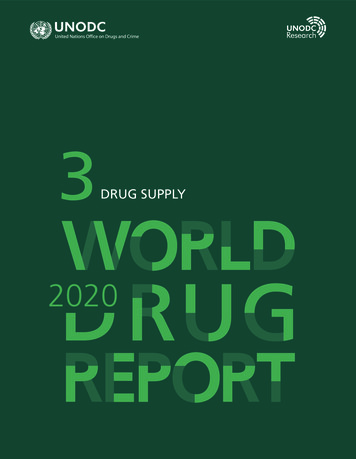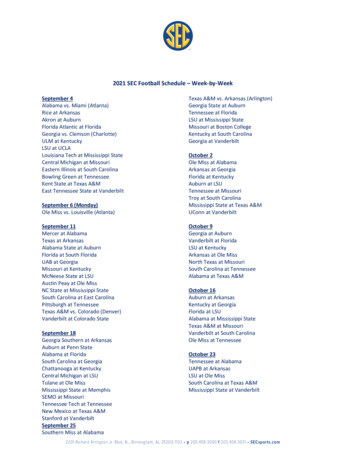
Transcription
3DRUG SUPPLY2020
United Nations, June 2020. All rights reserved worldwide.ISBN: 978-92-1-148345-1eISBN: 978-92-1-005047-0United Nations publication, Sales No. E.20.XI.6This publication may be reproduced in whole or in part and in any formfor educational or non-profit purposes without special permission fromthe copyright holder, provided acknowledgement of the source is made.The United Nations Office on Drugs and Crime (UNODC) would appreciatereceiving a copy of any publication that uses this publication as a source.Suggested citation:World Drug Report 2020 (United Nations publication, Sales No. E.20.XI.6).No use of this publication may be made for resale or any other commercial purposewhatsoever without prior permission in writing from UNODC.Applications for such permission, with a statement of purpose and intent of the reproduction,should be addressed to the Research and Trend Analysis Branch of UNODC.DISCLAIMERThe content of this publication does not necessarily reflect the views orpolicies of UNODC or contributory organizations, nor does it imply any endorsement.Comments on the report are welcome and can be sent to:Division for Policy Analysis and Public AffairsUnited Nations Office on Drugs and CrimePO Box 5001400 ViennaAustriaTel: ( 43) 1 26060 0Fax: ( 43) 1 26060 5827E-mail: wdr@un.orgWebsite: www.unodc.org/wdr2020
PREFACEThis is a time for science and solidarity, as UnitedNations Secretary-General António Guterres has said,highlighting the importance of trust in science andof working together to respond to the global COVID19 pandemic.The same holds true for our responses to the worlddrug problem. To be effective, balanced solutions todrug demand and supply must be rooted in evidenceand shared responsibility. This is more importantthan ever, as illicit drug challenges become increasingly complex, and the COVID-19 crisis andeconomic downturn threaten to worsen their impacts,on the poor, marginalized and vulnerable most of all.Some 35.6 million people suffer from drug use disorders globally. While more people use drugs indeveloped countries than in developing countries,and wealthier segments of society have a higher prevalence of drug use, people who are socially andeconomically disadvantaged are more likely to developdrug use disorders.Only one out of eight people who need drug-relatedtreatment receive it. While one out of three drug usersis a woman, only one out of five people in treatmentis a woman. People in prison settings, minorities,immigrants and displaced people also face barriers totreatment due to discrimination and stigma. Of the11 million people who inject drugs, half of them areliving with hepatitis C, and 1.4 million with HIV.Around 269 million people used drugs in 2018, up30 per cent from 2009, with adolescents and youngadults accounting for the largest share of users. Morepeople are using drugs, and there are more drugs, andmore types of drugs, than ever.Seizures of amphetamines quadrupled between 2009and 2018. Even as precursor control improves globally, traffickers and manufacturers are using designerchemicals, devised to circumvent international controls, to synthesize amphetamine, methamphetamineand ecstasy. Production of heroin and cocaine remainamong the highest levels recorded in modern times.The growth in global drug supply and demand poseschallenges to law enforcement, compounds healthrisks and complicates efforts to prevent and treat druguse disorders.At the same time, more than 80% of the world’spopulation, mostly living in low- and middle-incomecountries, are deprived of access to controlled drugsfor pain relief and other essential medical uses.Governments have repeatedly pledged to worktogether to address the many challenges posed by theworld drug problem, as part of commitments toachieve the Sustainable Development Goals, and mostrecently in the 2019 Ministerial Declaration adoptedby the Commission on Narcotic Drugs (CND). Butdata indicates that development assistance to addressdrug control has actually fallen over time.Balanced, comprehensive and effective responses todrugs depend on governments to live up to theirpromises, and provide support to leave no one behind.Health-centred, rights-based and gender-responsiveapproaches to drug use and related diseases deliverbetter public health outcomes. We need to do moreto share this learning and support implementation,most of all in developing countries, including bystrengthening cooperation with civil society andyouth organizations.The international community has an agreed legalframework and the commitments outlined in the2019 CND Ministerial Declaration. The UnitedNations Office on Drugs and Crime (UNODC) provides integrated support to build national capacitiesand strengthen international cooperation to turnpledges into effective action on the ground.The theme for this year’s International Day againstDrug Abuse and Illicit Trafficking, “Better Knowledgefor Better Care”, highlights the importance of scientific evidence to strengthen responses to the worlddrug problem and support the people who need us.It also speaks to the ultimate goal of drug control,namely the health and welfare of humankind.Through learning and understanding we find compassion and seek solutions in solidarity.It is in this spirit that I present the UNODC WorldDrug Report 2020, and I urge governments and allstakeholders to make the best use of this resource.Ghada WalyExecutive DirectorUnited Nations Office on Drugs and Crime1
AcknowledgementsThe World Drug Report 2020 was prepared by the Research and Trend Analysis Branch, Division forPolicy Analysis and Public Affairs, United Nations Office on Drugs and Crime (UNODC), under thesupervision of Jean-Luc Lemahieu, Director of the Division, and Angela Me, Chief of the Research andTrend Analysis Branch, and the coordination of Chloé Carpentier, Chief of the Drug Research Section.Content overviewChloé CarpentierAngela MeAnalysis and draftingThomas PietschmannSascha StruppData management and estimate productionEnrico BisognoHernan EpsteinAndrea OterováUmidjon RakhmonberdievFrancesca RosaAli SaadeddinAntoine VellaEditingJonathan GibbonsGraphic design and productionAnja KorenblikSuzanne KunnenKristina KuttnigFederica MartinelliData supportNatalia IvanovaLisa WeijlerAdministrative supportAndrada-Maria FilipIulia LazarMappingAntero KeskinenFrancesca MassanelloIrina TsoyLorenzo VitaReview and commentsThe World Drug Report 2020 benefited from the expertise of and invaluable contributions fromUNODC colleagues in all divisions.The Research and Trend Analysis Branch acknowledges the invaluable contributions and adviceprovided by the World Drug Report Scientific Advisory Committee:Jonathan CaulkinsAfarin Rahimi-MovagharPaul GriffithsPeter ReuterMarya HynesAlison RitterVicknasingam B. KasinatherFrancisco ThoumiCharles Parry
CONTENTSBOOKLET 1EXECUTIVE SUMMARY, IMPACT OF COVID-19, POLICY IMPLICATIONSBOOKLET 2DRUG USE AND HEALTH CONSEQUENCESBOOKLET 3DRUG SUPPLYPREFACE. 1EXPLANATORY NOTES. 5SCOPE OF THE BOOKLET. 7OPIATES. 9Opium poppy cultivation and opiate production. 9Opium production has been fluctuating greatly but global opiate seizureshave increased steadily over the past two decades. 11Opiate trafficking. 15COCAINE. 21Cultivation of coca bush and manufacture of cocaine. 21Quantities of cocaine seized show early signs of stabilization at a high level. 26Cocaine trafficking. 29AMPHETAMINE-TYPE STIMULANTS. 37Manufacture of amphetamine-type stimulants continues to be dominatedby methamphetamine. 37Quantity of amphetamine-type stimulants seized globally has increasedover the past two decades. 37Supply of methamphetamine. 39Supply of amphetamine. 53Supply of “ecstasy” . 60CANNABIS. 67Cannabis cultivation. 67Trafficking in cannabis. 70ANNEX. 75GLOSSARY. 91REGIONAL GROUPINGS. 93BOOKLET 4CROSS-CUTTING ISSUES: EVOLVING TRENDS AND NEW CHALLENGESBOOKLET 5SOCIOECONOMIC CHARACTERISTICS AND DRUG USE DISORDERSBOOKLET 6OTHER DRUG POLICY ISSUES3
EXPLANATORY NOTESThe designations employed and the presentation ofthe material in the World Drug Report do not implythe expression of any opinion whatsoever on thepart of the Secretariat of the United Nations concerning the legal status of any country, territory, cityor area, or of its authorities, or concerning the delimitation of its frontiers or boundaries.Countries and areas are referred to by the namesthat were in official use at the time the relevant datawere collected.Since there is some scientific and legal ambiguityabout the distinctions between “drug use”, “drugmisuse” and “drug abuse”, the neutral term “druguse” is used in the World Drug Report. The term“misuse” is used only to denote the non-medical useof prescription drugs.All uses of the word “drug” and the term “drug use”in the World Drug Report refer to substances controlled under the international drug controlconventions, and their non-medical use.All analysis contained in the World Drug Report isbased on the official data submitted by MemberStates to the UNODC through the annual reportquestionnaire unless indicated otherwise.The data on population used in the World DrugReport are taken from: World Population Prospects:The 2019 Revision (United Nations, Department ofEconomic and Social Affairs, Population Division).References to dollars ( ) are to United States dollars,unless otherwise stated.References to tons are to metric tons, unless otherwise stated.The following abbreviations have been used in thepresent booklet:AIDS acquired immunodeficiencysyndromeATS amphetamine-type stimulantsAPAAN alpha-phenylacetoacetonitrileASEAN Association of Southeast AsianNationsCOVID-19 coronavirus diseaseEuropol European Union Agency for LawEnforcement CooperationDEA Drug EnforcementAdministrationEMCDDA European Monitoring Centre forDrugs and Drug AddictionFARC Revolutionary Armed Forces ofColombiaha hectaresINCB International Narcotics ControlBoardMDMA 3,4-methylenedioxymethamphetamine3,4-MDP-2-P 3,4-methylenedioxyphenyl-2propanoneMDPV methylenedioxypyrovaleroneP-2-P 1-phenyl-2-propanonePMK piperonyl methyl ketoneUNODC United Nations Office on Drugsand Crime5
SCOPE OF THE BOOKLETThis, the third booklet of the World Drug Report2020, contributes evidence to support the international community in implementing operationalrecommendations dedicated to supply reductionand related measures, effective law enforcementand responses to drug-related crime, includingthe recommendations contained in the outcomedocument of the special session of the GeneralAssembly, held in 2016.The booklet provides an overview of the extent ofillicit crop cultivation and trends in drug traffickingat the global and regional levels. The analysis is presented by drug type and, using the latest estimatesas a basis, the booklet reviews the general situationand trends in the supply of opiates, cocaine, amphetamine-type stimulants and cannabis. In addition,some issues emerging in these markets are discussed,such as the impact of changes in illicit crop cultivation and production along the drug supply chain tothe main consumption markets, and emerging markets along the drug trafficking routes and beyondin other regions.Global iscocaineopiummethamphetamine139tonsheroin andmorphine73tons21tonspharmaceu cal amphetamineopioids12tonsecstasy7
Opiates3OPIATESChange fromprevious year2019-30%337,325 xGlobal produc onChange fromprevious year2019-0.1%6,126–6,426tonsu seproduced7,610 tonsof opiumconsumed as opiumOpium poppy cultivation andopiate productionOpium is illicitly produced in some 50 countriesworldwide, although the three countries where mostopium is produced have accounted for about 97 percent of global opium production over the past fiveyears.Afghanistan, the country where most opium is produced, which has accounted for approximately 84per cent of global opium production over the pastfive years, supplies markets in neighbouring countries, Europe, the Near and Middle East, South Asiaand Africa and to a small degree North America(notably Canada) and Oceania. Countries in SouthEast Asia – mostly Myanmar (some 7 per cent ofglobal opium production) and, to a lesser extent,the Lao People’s Democratic Republic (about 1 percent of global opium production) – supply marketsin East and South-East Asia and Oceania. Countriesrs58 millionrsse30 millionGlobal seizures201843processedinto heroin1,180–1,480 tonso p i oi240, 472–722tonsof heroin2019d0 ha80Global number of usersopiateuGlobal cul va ontonstons73tons96704morphinepharmaceu calopioidsheroinopiumtonsChange from previous year-50%-51%-6% 2%in Latin America – mostly Mexico (6 per cent ofglobal opium production) and, to a far lesser extent,Colombia and Guatemala (less than 1 per cent ofthe global total) – account for most of the heroinsupply to the United States and supply the comparatively small heroin markets of South America.Global area under opium poppycultivation declined for the secondyear in a row in 2019Despite a long-term upward trend, the global areaunder opium poppy cultivation declined by 17 percent in 2018 and then by 30 per cent in 2019, falling to an estimated 240,800 ha. Declines in the areaunder cultivation were reported in both Afghanistanand Myanmar in 2018 and 2019. Despite the recentdeclines, the global area under opium poppy cultivation is nevertheless still substantially larger thana decade ago and at similar level of the global areaunder coca cultivation.9
Opium poppy cultivation and production of opium, 201420152016201720182019050,000Area under poppy cultivationMyanmar, opium productionLao People's Dem. Rep., opium productionCultivation (hectares)Fig. 1Production (tons)WORLD DRUG REPORT 2020DRUG SUPPLY0Afghanistan, opium productionMexico, opium productionOther countries, opium productionSource: UNODC calculations based on illicit crop monitoring surveys; and UNODC, responses to the annual report questionnaire.Note: Data for 2019 are preliminary. For countries for which no estimates for 2019 are as yet available, the 2018 estimates have beenused as a proxy and those countries are included in the category of “other countries”.year (7,620 tons in 2018) and was 26 per cent lowerthan the peak reported in 2017 (10,270 tons).Global illicit opium production has also shown along-term upward trend, although it remained stableat 7,610 tons in 2019 compared with the previousDespite the decline in the area under opium poppycultivation in 2019, opium production remainedstable in 2019, with higher yields reported in themain opium production areas for 2019, as neitherdisease nor drought – as occurred in previous years– reduced opium output in 2019.2004,0001503,0001002,000501,000020172018Opium prices201902020Heroin pricesSource: Afghanistan, Ministry of Counter-Narcotics, Afghanistan drug pricemonitoring monthly report (April 2020), and previous years.10Price of high-quality heroin (dollars per kilogram)Average dry opium farm-gate prices and highquality heroin prices in Afghanistan, January2017–March te price of dry opium (dollars per kilogram)Fig. 2Global opium production remainedlargely stable in 2019Taking opium consumption into account, estimatedglobal opium production in 2019 would have beensufficient to manufacture 472–722 tons of heroin(expressed at export purities) – in other words, quantities similar to the previous year.Despite global opium production in 2018 being lessthan in 2017, there have been no indications to dateof a shortage in the supply of heroin to the respective consumer markets. In 2018 and 2019, bothopium and heroin prices declined in the main opiumproduction areas in Afghanistan, with opium farmgate prices falling by an average of 37 per cent (ona year earlier) in 2018 and by 24 per cent in 2019,while high-quality heroin prices fell by an averageof 11 per cent in 2018 and by 27 per cent in 2019in Afghanistan.1 Due to the bumper opium harvest1Afghanistan, Ministry of Counter-Narcotics and UNDOC,Afghanistan drug price monitoring monthly report (April2020), and previous years.
Opiatesof 2017, opium prices showed significant declinesat an earlier stage (starting in 2017) than did heroinprices (basically starting in 2018), suggesting thatit may have taken some time for clandestine heroinmanufacture to adjust to the overall greater availability of opium before expanding, as later reflected inlower heroin prices. At the same time, data also showthat, following two years of decreased opium production as compared with 2017, the downwardtrend in drug prices came to a halt, in the case ofopium, in June 2019, and a few months later, inAugust 2019, in the case of heroin as well. Prior tothe expected opium harvest in April/May 2020,however, opium prices started falling again inAfghanistan in March 2020 and the temporaryincrease in heroin prices at the beginning of 2020also came to a halt, both for high-quality andmedium-quality heroin.in the quantities of opiates seized than in the estimated quantities of opium produced. This suggeststhat law enforcement authorities may have becomemore efficient in intercepting trafficked opiatesworldwide. An alternative explanation is that a significant decline in heroin purity over the past twodecades has led to less-pure heroin being seized; butthis is not backed up by available data on the development of heroin purity over time.Opium production has been fluctuating greatly but global opiateseizures have increased steadilyover the past two decadesDespite a decline in 2018, the quantityof opiates seized globally remains at ahigh levelBoth opium production and opiate seizures haveshown an upward trend over the past two decades,although the increase has been more pronouncedAt the same time, annual opium production hasbeen fluctuating more than the quantity of opiatesseized and even more so than the annual quantityof heroin seized, suggesting the existence of opiateinventories. To offset fluctuations in opium production, opium may be temporarily stocked along thesupply chain, thus ensuring a smooth supply ofheroin to the main consumer markets.Despite a 19 per cent decline in the quantity of opiates seized globally from 2017 to 2018 (calculatedon the basis of converting those seizures into heroinequivalents), dropping to 210 tons, that was still thethird highest amount ever reported and 2,0001,0000Opium productionSeizures of heroinSeizures of pharmaceutical opioidsTrend, opiate seizures3002702402101801501209060300Seizures (tons)Global opium production and quantities of opioids seized, roduction (tons)Fig. 33Seizures of opium (in heroin equivalents)Seizures of morphineTrend, opium productionSources: UNODC calculations based on illicit crop monitoring surveys; and UNODC, responses to the annual report questionnaire.Note: A ratio of 10:1 was used to convert quantities of opium into heroin equivalents, and a ratio of 1:1 was used to convert quantities ofmorphine into heroin equivalents.11
WORLD DRUG REPORT 2020DRUG SUPPLYFig. 4Countries reporting the largest quantities of opiates seized, 2018OpiumIran (IslamicRepublic nMorphineIran (IslamicRepublic of)Iran (IslamicRepublic anada0.01Viet Nam1.8Turkey0.7Hong Kong,China0.01Kenya1.5Uzbekistan0.5United Sudan1.3Mexico0.3New 060Source: UNODC, responses to the annual report questionnaire.to exceed the quantity of pharmaceutical opioidsseized.2 The overall decline in the quantity of opiates seized in 2018 was mostly due to a decrease byhalf in the quantity of morphine seized. The quantityof opium and heroin seized, by contrast, remainedrather stable in 2018 ( 2 per cent for opium; and-6 per cent for heroin on a year earlier).212A direct comparison between seizures of opiates andpharmaceutical opioids is made difficult by variations inpotency between different substances. The largest quantityof the pharmaceutical opioids seized, i.e., tramadol andcodeine, accounting for more than 95 per cent of all pharmaceutical opioids seized in 2018, are clearly less potentthan heroin, while fentanyl, accounting for 4 per cent ofthe quantity of all pharmaceutical opioids seized is, inprinciple, 50 to 100 times more potent than heroin. However, the bulk of the fentanyl seized can be highly adulterated; for example, seized fentanyl substances contain, onaverage, 5 per cent of fentanyl in seizures analysed in theUnited States (Department of Justice, DEA, 2019 NationalDrug Threat Assessment (December 2019)), the countryresponsible for most of the fentanyl seized at the globallevel.The opiate seized in the largest quantity in 2018continued to be opium (704 tons), followed byheroin (97 tons) and morphine (43 tons). Expressedin heroin equivalents, however, heroin continuedto be seized in larger quantities than opium or morphine. Globally, 47 countries reported opiumseizures, 30 countries reported morphine seizuresand 103 countries reported heroin seizures in 2018,suggesting that trafficking in heroin continues tobe more widespread in geographical terms than trafficking in opium or morphine.The quantities of opium and morphine seized continued to be concentrated in just a few countries in2018, with three countries accounting for 98 percent of the global quantity of opium seized and 97per cent of the global quantity of morphine seized.By contrast, seizures of heroin continue to be morewidespread, with 54 per cent of the global quantityof heroin seized in 2018 accounted for by the threecountries with greatest seizures.
OpiatesQuantities of opiates seized remainconcentrated in Asia, notably in SouthWest AsiaMost opiates seized are reported in or close to themain opium production areas. Thus Asia, host tomore than 90 per cent of global illicit opium production and the world’s largest consumption marketfor opiates, accounted for almost 80 per cent of allopiates seized worldwide, as expressed in heroinequivalents, in 2018.The largest quantities of opiates continued to beseized in South-West Asia in 2018, accounting for98 per cent of the global quantity of opium seized,97 per cent of the global quantity of morphine seizedand 38 per cent of the global quantity of heroinseized that year (i.e., equivalent to 70 per cent of allopiates seized globally as expressed in heroin equivalents). Overall, 690 tons of opium, 42 tons ofmorphine and 37 tons of heroin were seized inSouth-West Asia in 2018.Expressed in common heroin equivalents, the country where the overall largest quantity of opiates wasseized in 2018 was once again the Islamic Republicof Iran, which accounted for more than half (53 percent) of the global total, followed by Afghanistan(12 per cent), Turkey (9 per cent), Pakistan (5 percent), the United States (4 per cent) and China (3per cent).Fig. 53The largest quantities of both opium and morphineseized were reported by the Islamic Republic of Iran,followed by Afghanistan and Pakistan, while seizuresreported by other countries remained comparativelymodest. The largest total quantity of heroin seizedby a country in 2018 was that seized by the IslamicRepublic of Iran (for the first time since 2014), followed by Turkey, the United States, China, Pakistan,Afghanistan and Belgium.Almost 70 per cent of the global quantities of heroinand morphine (the two main internationally trafficked opiates) seized in 2018 were intercepted inAsia, mostly in South-West Asia. The two subregions surrounding Afghanistan, South-West Asiaand Central Asia, together accounted for more than56 per cent of the global quantity of heroin andmorphine seized.Quantities of heroin and morphineseized declined in South-West AsiaIn parallel to the decrease in opium production,quantities of heroin and morphine seized in SouthWest Asia declined by 42 per cent in 2018, to 79tons, from the record high reported in 2017. Despitethe decline in 2018, the overall trend in seizures ofheroin and morphine in that subregion continuedto be an upward one over the period 2008–2018.South-West Asia continued to account for the majority of the global quantities of heroin and morphineDistribution of global quantities of heroin and morphine seized, %AfricaEurope2%22%Americas7%Asia69%Source: UNODC, responses to the annual report questionnaire.Note: Based on global quantities of opiates seized of 139 tons.Europe22%Near andMiddleEast/SouthWest Asia57%Near andMiddleEast/SouthWest Asia57%East and SouthEast Asia9%Other Asia3%East and SouthEast Asia9%Other Asia3%13
WORLD DRUG REPORT 2020DRUG SUPPLYseized globally in 2018 (close to 56 per cent), withthe largest quantities seized being reported by theIslamic Republic of Iran, followed by Afghanistanand Pakistan.Accounting for 9 per cent of the global total in 2018,the quantities of heroin and morphine seized in Eastand South-East Asia declined slightly in 2018. Mostheroin and morphine seizures in that subregion in2018 were again reported by China, accounting formore than half (53 per cent) of all such seizures,followed by Viet Nam, Malaysia, Myanmar, Thailand and the Lao People’s Democratic Republic.Quantities of heroin and morphine seized in othersubregions of Asia appear to have remained quitestable in 2018. That overall stable level obscures,however, the partial climb in heroin and morphineseizures reported in Central Asia and Transcaucasiafollowing years of ongoing declines, and the declinein 2018 of seizures in South Asia, which follows aseries of strong increases up to 2017.Quantities of heroin and morphineseized have reached record levels inEuropeThe largest total quantity of heroin and morphineseized in a region outside Asia is that reported forEurope (22 per cent of the global total in 2018),which is an important market for the consumptionof heroin. Heroin and morphine seized in Easternand South-Eastern Europe continued to accountfor the bulk (66 per cent) of all such quantities seizedin Europe in 2018, with most of the heroin andmorphine seized in the region continuing to bereported by Turkey (62 per cent), followed by Western and Central Europe (31 per cent) and EasternEurope (3 per cent) in 2018.The quantities of heroin and morphine seized inEurope more than doubled in 2017 and rose by afurther 24 per cent in 2018 to reach a record levelof 30 tons, thus exceeding the previous record levelof 29 tons in 2008. While the strongest increase inthe quantities of heroin and morphine seized in2017 was reported in Eastern and South-EasternEurope (the same year as the bumper opium harvestreported in Afghanistan), the strongest increase in2018 was reported in Western and Central Europe(89 per cent). This suggests that it may take a yearfrom when opium is harvested in Afghanistan until14it is manufactured into the heroin that ends up onthe streets of Western and Central Europe. Therewere increases in heroin and morphine seizures inEurope in the countries along the Balkan route in2018, although most of the increase was due to anincrease in the quanti
drug demand and supply must be rooted in evidence and shared responsibility. This is more important than ever, as illicit drug challenges become increas-ingly complex, and the COVID-19 crisis and economic downturn threaten to worsen their impacts, on the poor, marginalized and vulnerable most of all. Some 35.6 million people suffer from drug .










